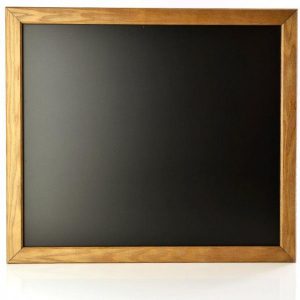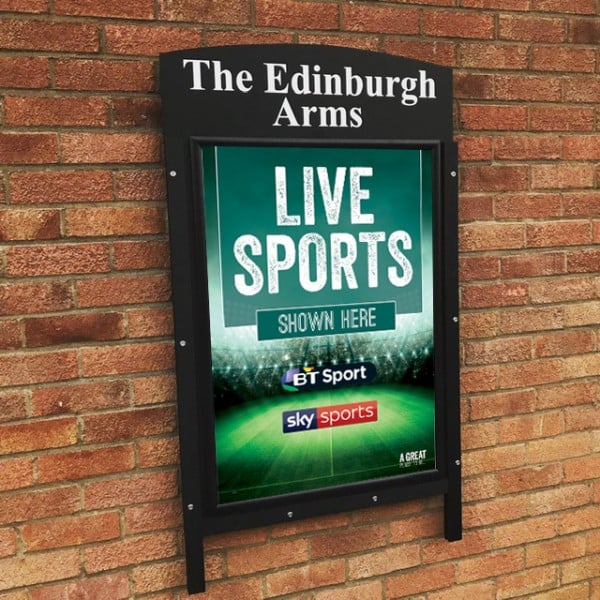If you’re affected by an A-board ban and need an alternative to using pavement signs, Majisign can help!
Local councils and business improvement groups have been managing our streets, shopping centres and retail parks for years. More recently, many have published best practice guides and design principles that encourage sensible use of pavement signs.
However, in many areas throughout the UK, the use of A-Boards and other on-street advertising structures are now subject to consent or have been totally banned. This article explains more about bans, restrictions and what you can do to maintain a high-level of promotion using A-Board alternatives.
Aside from our stock wall-mounted products, Majisign can manufacture bespoke signage for most circumstances
If you’re already aware of restrictions or limitations in your business area, meaning that you’re not allowed to advertise your business by using a pavement sign (or it needs to be of a particular specification), Majisign can help!
You can skip straight to our leading alternative products by clicking here, or have a longer read by scrolling down.
Note that the following information has been interpreted from various council, Business Improvement District, and government websites, meaning that is for informative purposes only. If you need specific and current/enforced guidance please contact your local council.
Who decides that a ban is needed?
Most local authorities have specified guidelines for the use of free-standing advertising boards. Generally, Councils control the public highway, meaning that they decide upon if any advertising items may be displayed on the road, including the pavement.
Finding out which policies are enforced in your area may require some research. Not all land is deemed a public highway; some areas outside business premises are leased or privately owned, making it harder to know exactly what to do when considering if any kind of pavement sign is allowed. To potentially confuse further, often commercial premises will be part of a Business Improvement District body or another initiative, meaning that is their guidance that should be followed.
A BID is summarised as “A Business Improvement District (BID) is a partnership between a local authority and local businesses which is intended to provide improvements to the public sphere within a specified geographical area. “
Our advice is to check with your local council or BID before placing a pavement sign or advertising board outside of your business premises. You can read more about BIDs here.
Even if you’re not directly affected, you should still consider where best to place an A-Board or other sign. The best places are where you won’t be creating an obstruction yet your advertising is still visible. The goal is to promote your business whilst maintaining a good level of accessibility by using a high-quality, appropriately styled pavement sign.
What items are prohibited or require consent to display?
Advertising boards and free-standing signs are often regulated in high-density areas such as city centres, although other areas and property types can attract the need for consent. It’s not always obvious what kinds of items may be applicable as many policies state “A-Boards and comparable objects”. Here’s a list we’ve curated from UK councils and other bodies.
- Free-standing A-Boards & pavement signs
- Hanging or propped-up advertising boards
- Mannequins
- Menus and poster frames
- Lecterns
- Planters
- Goods on display
- Estate Agent boards
- Mills or Crowd barriers
- Lamppost and pole wraps
- Railing boards
- Hoardings (for advertising, shops, and construction)
If there aren’t any specific guidelines for these types of items, you should inquire with your local authority as you may need to apply for advertisement or listed building consent.
Advertisement or listed building consent is usually required when a display item is larger than a specified size, is illuminated or your premises is listed. Application forms can vary in terms of the information that you’ll need to supply. Generally, though, they will ask for;
- Plans and drawings that demonstrate your proposal
- Siting of the advertisement, including materials, colours, height, and projection
If you require any outer dimension drawings of a Majisign sign (bespoke or stock), please let our sales team know so that we can assist you.
Alternatives to ‘A’ Boards
Here are some of Majisign’s stock products that can help you to comply with local restrictions.
Most A-Board and signage bans are concerned with “street clutter”. Therefore, you can choose a wall-mounted product, such as an external ash-framed chalkboard.
This wooden poster frame is made from solid American ash making it robust and long-lasting. Posters are held in place with magnetic strips at the top and bottom of the cabinet. It also features a chalkboard! Majisign uses genuine Perspex; stronger, lighter with less glare than glass. Click here to buy.

This hardwood framed chalkboard can withstand the weather and uses an exterior grade MDF for the chalkboard. Manufactured by Majisign, this framed chalkboard is finished to a high standard, for all weathers-

Alternatively, the exterior slimlock case is manufactured from aluminium and displays posters. Majisign’s posters can be printed on PVC, meaning that they’re able to withstand condensation;

Majisign’s Edinburgh A-Board product is one half of the traditional a-board pavement sign and can be wall-mounted! Choose from a poster snap frame, or plain chalkboard. For wall-mounted solutions such as this, please contact the team.

The main advantage of a pavement sign is that they’re easy to put out- just place on the floor! However with increasing limitations, we understand that your needs may be unique. We’re able to manufacture any sign, frame and other wooden display to meet your exact requirements. From general signage to bespoke shapes and printing, Majisign is able to help.
Findings from Edinburgh’s ban on A-Boards
On the 5th November 2018, Edinburgh’s Transport and Environment Committee banned A-Boards and other temporary on-street advertising structures. 1 year later they reviewed that decision. Interestingly they found;
- It has prompted positive feedback regarding accessibility, safety, and appearance of the city
- Particularly positive feedback from people with sight and/or mobility impairment
- Negative fluctuations in footfall, particularly to those businesses in harder to find locations
The initial proposal to implement a ban sought to improve accessibility and safety and improve the appearance of the city’s streets, whilst being fair to all businesses, clearly understood and enforceable. Part of the decision was to support businesses so that they could mitigate any negative effect on footfall or trade.
The 12-month review quotes many equality-focussed organisations; unanimous in their positive feedback. For businesses though, the feedback was mixed. Most cited concerns where their business was harder to find and relied on passing footfall, although the Chamber of Commerce reported that there hadn’t been much feedback from businesses. Many businesses provided positive feedback, especially as they could now attract people who were previously less likely to visit the city centre based on accessibility issues. Some of the concerns reported were;
- Small businesses could be affected since they do not have the budget to invest in other forms of advertising
- Hard to find businesses would see a decline in trade especially when reliant on footfall
- The perception that enforcement varied caused issues since businesses wanted a fair and robust method that also arranged for appropriate support
Edinburgh’s council came to the following conclusions in their 12-month review report:
- The primary aim behind the citywide ban was to improve pedestrian accessibility and safety for everyone. Equality was at the heart of this decision. The ban has achieved this aim.
- The feedback from stakeholders including those with an equality focus, community groups, public safety experts, heritage organisations and some members of the public confirm that the ban has been a success. The ban has also had a positive impact on the city’s appearance through the reduction in visual clutter.
- Despite some concerns around the ban’s impact on footfall and trade, most businesses have adapted well, with alternatives being implemented across the city. Support will continue to be offered to businesses who require guidance on alternative ways to advertise.
- Levels of voluntary compliance with the ban have been high and enforcement, both through ensuring awareness and dealing with persistent offenders, continues to be successfully undertaken.
Do I need consent, a license or are advertising boards banned?
Generally, local authorities that allow A-Boards shall want you to make an application so that consent can be granted. In some cases, this can attract an annual fee (a license). Where a ban is enforced, you need to be aware of what is allowed and what costs could be incurred; typically for removal and reclaim. Some councils allow pavements signs and support this with a code of practice.
Lichfield District Council has published a Code of practice for A-Boards. Many of the values are shared with those councils that have enforced a ban. Their code, aside from requesting that businesses do not create an obstruction, raises some interesting requirements:
- If the building is occupied by more than one business – such as a shopping arcade or alleyway – a composite a-board or display case could be used to advertise more than one business. However, a display case would need to be approved by the council.
- A-boards and display furniture must be constructed of suitable materials so they don’t blow over. They should also be kept in good repair and contrast with their background so they are easier for partially sighted people to see.
- The quality of design and any display furniture should not detract from the character and appearance of the area – especially in conservation areas.
- As a guide, a-boards/displays should be around 60cm wide and 1m tall.
The above demonstrates the variety of requirements that are set at a local level and why it’s really important for you to find out anything that may affect your promotions.
The Royal Borough of Windsor & Maidenhead has published a single-page statement on the use of Advertising Boards.
Many traders, public and restaurateurs seek to attract attention to their businesses by way of an advertising board (A Board) placed in a location outside or remote from their premises in the hope of generating interest from passing trade.
While we are sympathetic to the need for businesses to increase trade, items such as these present an obstruction for pedestrians and it is our policy not to allow any of them to be placed on highway areas within the borough.
In most cases the highway includes the carriageway, the footway [pavement] and the verges.
We would ask therefore that if such items are to be used that they are placed only on private areas that do not form part of the highway.
It’s a clear statement that all businesses can follow.
If I am granted consent, what am I allowed to display?
Naturally, requirements vary between districts and boroughs and it’s interesting to know the sort of limitations that shall still exist after consent. Below are some example limitations:
· 1 A-Board or equivalent per business
· Must be displayed within the property’s frontage and is not a hazard (e.g. in front of doorways, emergency exits, bus stops, etc.)
· Maximum size is A1
· Swivel/rotating, swinging or illuminated signs are prohibited
· Must be freestanding and immediately movable (i.e. by hand)
· Can only be displayed during business or daylight hours (whichever is of the shortest duration)
· The licensee (i.e. the person that has been granted consent) must have valid public liability insurance
Who does the policy apply to and where is it enforced?
Private and public organisations and businesses, often within a specified area.
The guidelines will often contain information about placement, where they are prohibited, size limitations and crucially, what to do if you want to display an item.
Take York City for example. Their guidance specifies an A-Board Prohibition Zone within the city centre. They have made an exemption in the Micklegate area;
“We consider Micklegate to be an appropriate location for ‘A’ Boards due to pavement widths and other characteristics, which are not typical of other streets within the ‘A’ Boards prohibition zone.“.
However, to display an A-Board in this area, a license must be applied for, which lasts for 1 year and costs £110.
Sometimes the control of advertising boards is applied to the Council’s responsibility to maintain and control the public highways. Bradford Council described this as:
“‘Public highway’ in this instance is defined as a footway, verge, carriageway or public right of way between the boundaries of private property which could be adopted or un-adopted. Dedicated park land and private land are not classed as public highway. We do not have any powers to enforce removal of A-boards on private land next to the public highway.”
Bradford Council’s Executive Committee voted to impose a district-wide ban on advertising A-boards on the public highway, following a successful 12-month trial ban within designated areas of the district.
Management and enforcement methods
Councils will often employ Environmental wardens. Enforcement, whilst critical, is often interpreted as a confrontation that would negatively impact a business. In the case of Edinburgh, support is given to businesses so that alternate means of advertising can be arranged. Over the last 12 months in Edinburgh;
“Since the ban was implemented, 222 premises have been instructed to remove their structures. Of those 222, 193 complied and 29 premises received a formal notice requiring the removal of the structure. Of those 29, 15 complied and 14 structures required to be confiscated from 8 premises. This stepped process has been successful in ensuring compliance.”
Edinburgh’s council manages a ‘one-stop-shop’ for businesses needing support, as well as linking to digital “boost” resources. Their report says
“Generally, the support offered to businesses in exploring different ways to advertise and promote their premises has been well received. Creative window displays and signs displaying daily offers, for example using blackboard-style signs, have been noted. Clarity has been provided as early as possible where certain types of signage is not acceptable.“
Bradford Council follows a procedure of using Council Officers to visit the site, collect evidence and then make contact with the Business owner, requesting the item is removed or by the next day. If this is not followed, they shall remove the A-Board, store it for 28 days. Anyone wishing to reclaim the A-board will be charged a storage fee (later described as a levy on removal and storage costs) – the current charge is £250. After 28 days the A-Board will be destroyed. If there are 3 repeat instances, the Council will consider issuing a Community Protection Notice.
Background issues which lead to the need for a defined policy
Many councils are changing their policies under health & safety legislation. Often this is combined with making equality improvements so that high-density areas are easier to navigate and historical buildings preserved. The reduction of pavement items (or clutter) is key to achieving these goals. Creating an obstruction can be detrimental, which is why consent is required or a total ban enforced.
Conclusion
- Contact your local authority if you’ve any queries about the use of A-boards, Sandwich boards and any on-street display products
- Consider the placement of your signage, even if on private land, to maximise accessibility for everybody
- Contact Majisign if you need an alternative to an A-Board
- Shopping for A-Boards? Click here to see our fantastic range of wooden a-boards!
- Remember that consent may come with limitations – if you need a product that complies, let us know!
References
City of York Council’s ‘A’ Boards policy
Control of advertising boards on the highway pavements of the Bradford District
Wandsworth: Restrictions on the display of estate agent boards
Lichfield District Council A-boards code of practice
Windsor and Maidenhead: The use of advertising boards in the Royal Borough
House of Commons Library: Business Improvement Districts
